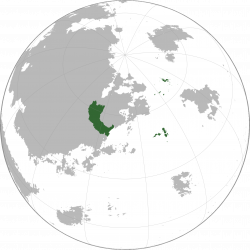Fazulavaz
| Faźul Republic Tyurinztaś faźulo |
||||||
|---|---|---|---|---|---|---|
|
||||||
| Motto: cupittaś śaktaśsan | ||||||
| Anthem: tyurinztaśev tagely | ||||||
Location of Faźulavaz in Miraria
|
||||||
| Capital and largest city | Creniz | |||||
| Official languages | Fazul | |||||
| Recognised regional languages | Juhash Achiyitqan Vodholk |
|||||
| Ethnic groups (2013) | 62.5% Faźul 25.8% Juhash 6.3% Maakpauean 0.8% Vodholk 2.8% Other |
|||||
| Demonym | Faźul, Faźuli | |||||
| Government | Unitary semi-presidential republic | |||||
| - | President | Ketis Erim | ||||
| - | Chancellor | Iśa Preśeća | ||||
| Legislature | Ośaves | |||||
| Area | ||||||
| - | Total | 1,262,169 km2 487,326 sq mi |
||||
| Population | ||||||
| - | 2019 estimate | 3,345,925 | ||||
| - | Density | 2.65/km2 6.9/sq mi |
||||
| GDP (PPP) | 2019 estimate | |||||
| - | Total | $103 billion | ||||
| - | Per capita | $31,015 | ||||
| GDP (nominal) | 2019 estimate | |||||
| - | Total | $50.0 billion | ||||
| - | Per capita | $14,951 | ||||
| Gini | 30.73 medium |
|||||
| HDI | 0.84 very high |
|||||
| Currency | Nedźi (FLN) | |||||
| Time zone | SCT+8 in Miriria, SCT+11 in Tlukera and Deyatsan | |||||
| Drives on the | right | |||||
| Calling code | +43 | |||||
| Internet TLD | .fl | |||||
Fazulavaz (Faźul: Faźulavaz [fɑʒulɑβɑt͡s]), officially the Fazul Republic, is a country in northeastern Miraria, bordering Achiyitqana to the north, Kasiiralq to the north and northeast, the Gulf of Nehil to the east, Juhashka to the south, in addition to the island province of Tlukeria in the Shaelic sea. Its largest city is Creniz. Other significant cities are Fec, Prels, Gurz and Kamato.
Nivoic Mahavic peoples are believed to have settled the eastern Mirarian coast as early as 400 CE. Unlike the nomadic Jovic tribes to the west, these Mahavic tribes lived a largely sedentary lifestyle, mixing agriculture with traditional hunting and fishing practices. Many minor kingdoms and city-states sprang up, including large areas of modern-day Juhashka and central Athsud. During the 12th century, these were conquered by the Sunrise Horde, culminating in the Great Siege of Creniz in 1190. Initially, the Fazul were treated as subordinates to the Juhash and the use of their language was banned in public. Gradually, however, a mutualistic relationship developed between the two cultures, and many Fazul reached great prominence during the mid Galkhai Dynasty. In 1505 the capital was moved from Kahat to Creniz, and the largely ethnic Juhash court began to adopt Fazul in public. In 1617 a rebellion against the highly unpopular Yede Burcar led to the overthrow of the Galkhai by the ethnic Fazul Y dynasty.


